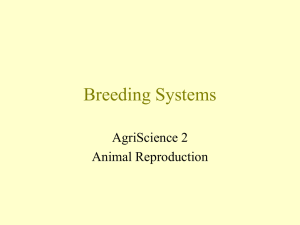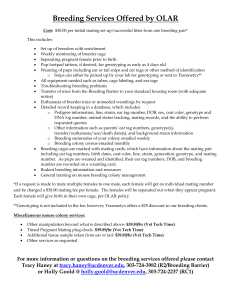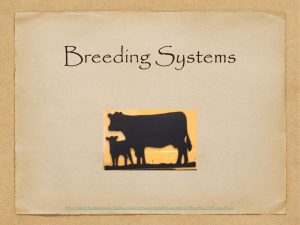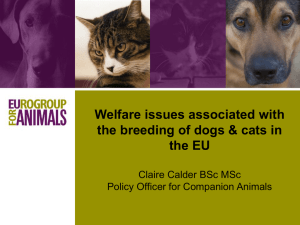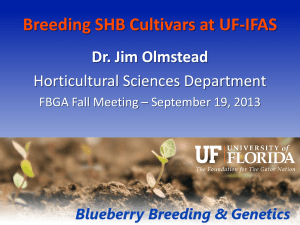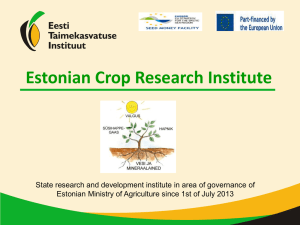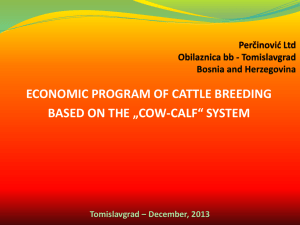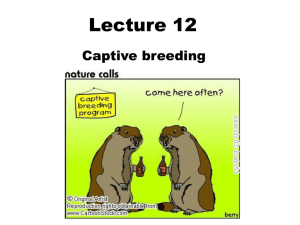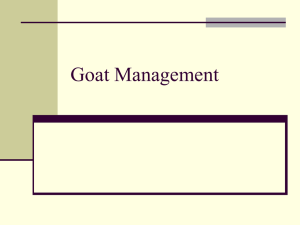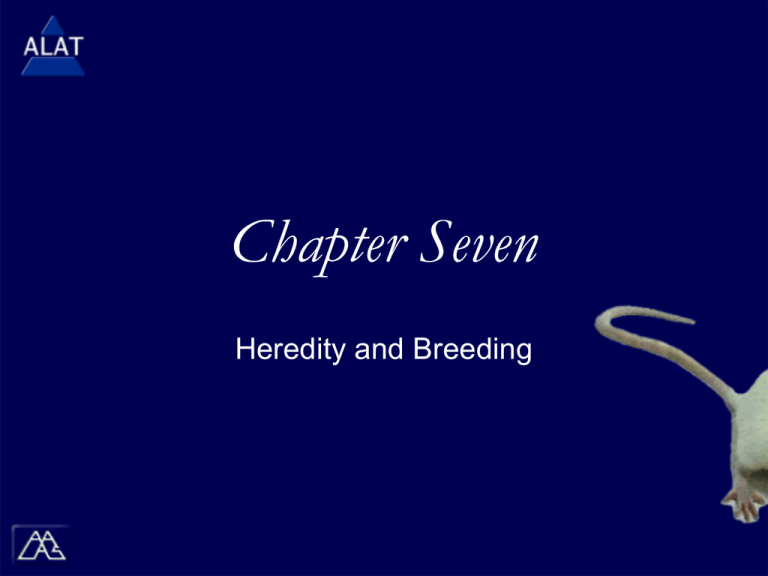
Chapter Seven
Heredity and Breeding
ALAT Presentations Study Tips
If viewing this in PowerPoint, use the
icon to run
the show (bottom left of screen).
Mac users go to “Slide Show > View Show” in menu bar
Click on the Audio icon:
when it appears on the
left of the slide to hear the narration.
From “File > Print” in the menu bar, choose “notes
pages”, “slides 3 per page” or “outline view” for
taking notes as you listen and watch the
presentation.
Start your own notebook with a 3 ring binder, for later study!
Breeding and Husbandry
Genetics deals with heredity.
why offspring resemble or differ from their parents
Similarities and differences:
due to heredity
caused by environmental factors or mutations
Successful breeding of animals depends on:
an understanding of basic genetics
breeding system that suits the needs of a particular
protocol.
Genes & Chromosomes
Physical characteristics of organisms are passed
from one generation to next by genes.
an inherited characteristic such as fur or eye color,
number of toes or the length of the intestine
Genes are on chromosomes & made of DNA.
Chromosomes = paired structures in cell nuclei.
Number of pairs differs for various species.
Normal members of a species have = number of pairs.
Only ova & sperm chromosomes are not paired.
When the ovum is fertilized by the sperm, the zygote
forms paired chromosomes from the unpaired sets.
Half of each parent’s genes passed to next generation.
Expression &
Mutation
Expression is result of
interaction of paired genes.
Genes can be either dominant or recessive.
Recessive brown fur gene & dominant black fur =
expression of dominant black gene (black fur).
Gene may mutate when passed parent to
offspring.
Mutations may occur spontaneously or by chemical
& physical environmental factors.
Can be either harmful or beneficial.
Such animals have potential use as a model to
help understand diseases or phenomena.
Reproduction
1st step in sexual reproduction is production of
sperm & eggs.
Fertilization location/manner depend on species.
In most mammals fertilization occurs within ’s
reproductive tract.
In other types of animals, it occurs outside the body.
Development site also depends on species.
In most mammals, zygote becomes implanted & grows
in the uterus.
In birds and reptiles, embryonic development usually
occurs outside body, inside an egg.
(Image) Female Internal Reproductive
Organs
Gestation & Estrus
Time required for a zygote to develop into a fetus
& be born = gestation period.
Natural end of gestation period called parturition.
Males produce sperm continually & are ready to
mate almost any time after reaching maturity.
Females mate only during specific times.
During estrous cycles, female’s eggs undergo
changes which prepare them for fertilization.
During estrus the female allows mating.
Ovulation usually occurs at or near this time.
Cells in vaginal wall change in phases of cycle.
In some species samples can be collected from the vagina &
examined to determine phase of estrous cycle.
(Image) Embryonic Growth Phases
Breeding Schemes
Breeding schemes determine how similar or
different parents are from offspring.
Scheme depends on animal & requirements.
Inbreeding is used to produce animals with
minimal genetic variation.
share characteristics & are identified as specific strain
Strains are inbred after >20 generations.
Rodents are the most frequently inbred animals.
C57BL, DBA/2, C3H, and BALB/c
A mating to an unrelated animal or a different
strain contaminates the inbred line.
Escaped animal should not be returned to a cage.
Breeding Schemes II
Outbreeding is a scheme of breeding in which
only unrelated animals of the same stock are
mated.
Frequently used in rodent colony management.
Results in maximum genetic difference among
animals.
Usually more vigorous animals & larger litter size.
CF1, ICR, and Swiss
Other breeding schemes
usually involve mating for
desirable characteristics.
Animals share a common ancestor = line breeding.
Cross breeding = mating animals of different breeds.
Mating Systems
After determining genetic type required for a
project & selecting mating system appropriate to
species being used, more than one mating
system may be appropriate.
depends on management considerations
Monogamous mating = 1 & 1 paired together
for the duration of their breeding life.
Simplifies record keeping & lends itself well to
maintaining inbred or outbred colonies.
Gerbil is bred most successfully with
monogamous pairs.
Harem Mating
Polygamous mating system = 1
with > 2
s
results in large # of young from least # of breeders
economical method of production
difficult to keep accurate records
s often share nursing responsibilities, causes uncertainty of
which female gave birth to offspring.
for colonies when not critical to know which is the mother
Cage must be large enough for adults and young
until offspring are weaned.
Separate housed & are together for breeding.
Reduces # of animals needed, permits accurate record
keeping, but labor costs are high.
Used when s kill the young or & are aggressive.
Other Breeding Concerns
Consideration should be given to selection of
good breeding stock.
Animals should be healthy, young &
nonaggressive.
Females should exhibit good mothering
characteristics & adequate milk production.
The health of breeding animals must
be monitored and sign of illness or
disease should be reported immediately.
Maintenance of Breeding Animals
Rodents & rabbits may desert, kill or cannibalize
their young if disturbed.
Delay cage changes for a few days following birth.
Minimal handling of newborn animals is a general rule.
Wean ~ 21 days of age in rats and mice.
Rodents build nests if provided soft paper,
shredded wood fiber or cotton.
Rabbits require a nest box & pull hair to line nest.
12–14 hours of light is best for
rodent breeding colonies.
The longer light period helps
establish consistent estrous cycles.
Record Keeping
The following are examples of information that
could be kept for a breeding colony:
Breed, strain and type of animal
Parentage or ancestry
Animal identification number
Sex
Date mated
Date of birth and number of offspring
Date weaned and number of offspring
Sex of young
Veterinary information
Animal Identification
Identify individual animals.
critical for determining parentage and lineage
Mixing animals in a cage or placing an animal in
a different cage without proper identification can
be devastating to a research project.
Cage cards are used to
identify each animal or
group of animals.
Card contains information about
history, genetic background,
IACUC #, type of experiment & contact.
Short-Term ID
Clipping or shaving various
locations or patterns
Nontoxic, waterproof dyes or markers
Markings, colors, sex, hair or breed
Collars for cats, dogs and nonhuman primates
Must be routinely checked as animal grows.
Loose-fitting collar could get snagged on cage.
Dogs and cats purchased from commercial
suppliers have a USDA number on record.
USDA tag may be left on collared animals.
Collars may cause skin irritation & strangulation &
interfere with neck bandages & other apparatus.
Permanent Identification Methods
Implantable microchip transponders transmit ID.
Subcutaneous chip implanted
Recording device scans chip and reads #
Ear notching = holes at various positions
Notches & holes = a numbering code.
Easy to read and produces little trauma to animal.
Used in pigs & rodents, not hamsters & guinea pigs.
Holes or notches close over a period of time.
Sanitize punch tool between animals.
Toe clipping must have strong justification.
removal of 1st bone of certain toes = a # code
>time, >difficult, >stress than ear marking
Anesthesia is recommended.
Ear & Wing Tags
Small metal clips are stamped with individual #’s.
Using special pliers, they are applied near the
base of the ear or to the wing.
Procedure is quick and causes minimal pain.
Used on rodents, rabbits, sheep & birds.
As with ear notching, the ID can be lost.
In birds a numbered leg band is an alternative to
a wing tag.
Tattooing
2 types of tattooing devices:
Hand-operated instrument clamps onto ear so pointed
tips pierce skin and ink dyes the underlying tissue.
Electrical pen-like tool has a reciprocating multi-point
needle which marks the skin.
Ink is massaged into skin perforations.
Clean & disinfect instruments between animals.
Ear tattoo ID in rabbits
Avoid damage to medial artery or marginal ear vein.
Use black ink on lighter colored breeds.
Green ink on dark-colored breeds
Tattoo may spread as animal grows, making the tattoo
unreadable and tattoo may have to be redone.
Tattooing Continued
Ears - g. pigs, cats, dogs, monkeys & ungulates
Dogs - ears, skin of flanks or oral cavity
Dogs anesthetized and tattoo area is clipped, washed
& dried.
Nonhuman primates - chest or inner thigh
Even individually housed animals should be
tattooed & a cage card posted w/ all other info.
Neonatal rats & mice may be permanently ID’d
by injecting tattoo ink subcutaneously
into ears, tail, hocks or toes, using
a series or pattern of dots.
Additional Reading
Nicholas, F.W. Veterinary Genetics. Iowa State
University Press, Ames, IA. 1987.

